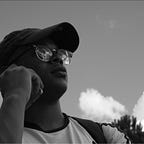How Climate Change is Impacting College Students
These past couple of years we have seen some of the most bizarre weather conditions across the world. Our climate is changing, so what does that mean for young people left to live in this new reality? I interviewed two college students who have both experienced the most extreme weather conditions that have been brought on by climate change.
First we hear from Jennie Olivas, a junior at Colorado State. She’s lived in Colorado all her life, born and raised in Denver then for college she decided to travel an hour away to Fort Collins. Also an hour away from Fort Collins is Rocky Mountain National Park. A 415 square mile park that had lost over 46 square miles of land last year due to a wildfire that went on from August to late October. This was one of many National Parks in Colorado impacted by wildfires as Colorado experienced two of the worst wildfires in Colorado’s history.
Olivias and over 33,000 other students attend Colorado State. With one of the largest wildfires going on only 30 miles away at the Rocky Mountain National Park it put the entire campus at risk.
While already managing the stress of class, and the threat of COVID-19 on her campus. Olivas had to add the fear of losing her entire school to a wildfire. Olivias was reminded daily of the threat this wildfire put onto her and her school.
“The smell of the smoke was so bad that it got into your clothes similar to when you go camping, and have a campfire,” Olivias said. “Also it would be super dark in the middle of the day as if it was night time.”
This became Olivias’s new reality there was no escaping the smell of smoke and the ash filled skies. Olivas also mentioned how the firefighters had to camp out at a reservoir 15 mins away from her campus 24 hours a day for a few days to avoid this fire from reaching her campus.
Olivias was not only thankful for those people who put their lives on the line for her, but worried a lot about them and their family members. There was no guarantee that they would make it home safely, but continued to do their part to help stop the fire.
The fire ban on the park that was put in place August 14, 2020 was lifted three days before Christmas. Although most of the fire is out, the city of Fort Collins now faces a water quality issue as ash and sediment layoff from the burned areas have now reached their water supply.
While Colorado was left to recover from these damages Texas was hit with one of the worst natural disasters that nobody saw coming.
Taylore Gills, a junior at Spelman College was left devastated by the winter storm that hit Houston back in January. Gills was born in Houston and raised in both Houston and San Antonio. Gills did not see this coming at all as it left Dallas, Houston, Austin, and San Antonio with no power or running water.
“Texas having snow is something that is not normal at all,” Gills said.
Gills was forced to face that harsh reality as she was forced to sleep in the family car along with her mother and two older brothers in order to stay warm. Gills and her family lost most of their food as a result of the power outage, and there were very few places to find food.
“We had to wait in line for hours in order to get food,” Gills said. “The amount of people in the few stores that didn’t lose power was crazy, and the grocery stores that had thrown out their food had police guarding their trash”.
Gills also had no choice, but to miss class she had no Wi-Fi to connect to the internet with the only place for her to charge her electronics was the family car.
These Natural Disasters have not only been extremely powerful, but abnormal as well. The only reasonable explanation to describe these conditions is to call it what is Climate Change. What exactly lies ahead is unknown, but our generation is seeing Climate Change in it’s lethal form.
